- Home
- Mary Roach
My Planet: Finding Humor in the Oddest Places Page 4
My Planet: Finding Humor in the Oddest Places Read online
Page 4
Frequent Flierrr#*!
My father-in-law turned 80 this year, and there was a big party in South Florida. A few months beforehand, I decided to use up some frequent flier miles and go. I called United, because they’ve filed for Chapter 11 and I wanted to get rid of my miles before they get to Chapter 12, which is the chapter where they cut out 70 percent of their routes and start serving Kool-Aid and salami ends.
I gave the frequent flier man the date. There was nothing into Fort Lauderdale, nothing into West Palm Beach. Perhaps it was a blackout date. Frequent Flier Plans, as you know, have more blackout dates than Anna Nicole Smith. It certainly wasn’t a holiday, unless you count Bunsen Burner Day. But this hardly merits a blackout.
Bunsen burners may well get the day off, may well wish to go and visit their relatives, but, tragically, FAA regulations prohibit Bunsen burners on airplanes.
There was a flight into Miami, which I said I’d take. I’ll rent a car, I said. I’ve got lots of those free rental car certificates that the frequent flier programs send you to make you feel better about having to fly into the wrong city on the wrong day. Then again, there’s a reason I have lots of these. I can’t find anyplace that’ll honor one. I’ll walk up to the counter and hand the woman my certificate, and she’ll start shaking her head. “Today is Wednesday,” she’ll say slowly and with fraying patience, as though talking to a small driver’s-license-bearing child. “This coupon is for the third Friday of a month ending in E. It says right here it must be used before National Foot Health Day yet after the start of the Tule Elk rut season. Besides, we have nothing left but locomotives, and this coupon isn’t good for those.”
“Oh, one thing,” said the United Man. “The Miami flight is on the day before you want to leave. Is that okay? And I see it leaves out of San Jose, not San Francisco. Does that work for you?”
“Sure,” I said. “Oh, one thing. My credit card is expired, so I was going to pay you in Betty Crocker coupons. Does that work for you? And I’ll be traveling with a family of Bunsen burners. Is that okay?”
The man from United had an idea. He said that if I cashed in 40,000 miles instead of 25,000 miles, there would be more seats available. This would put me in the No Restrictions Category. Unfortunately, it would also put me in the Gave Up a Free Trip to Hawaii Category.
He found me a flight into Fort Lauderdale, and then he said, “There is one stopover. In Chicago.” Unless you are trying to draw Anna Nicole Smith with your flight pattern, you don’t fly up to Chicago and back down to get to Florida. Clearly we had moved on to Chapter 12. We were right on the brink of Chapter 13, where the CEO sells the company to Air Burundi and you’re out of luck unless you happen to be traveling to Bujumbura, and even then you’re going to have a plane change in Chicago.
“Okay,” I said to the United Man. “Let’s say for the sake of argument that I decide to do this. Let’s say I trade in my free trip to Hawaii for the opportunity to spend 12 hours with my knees inside a stranger’s kidneys, eating embalmed chicken and breathing last year’s air. What does the return look like?”
The return looked like an ad for prescription-strength pain reliever. It was one of the busiest days of the year, the man said. All the flights were overbooked. For the Sunday I planned to return was the last day of Spring Break. Spring Break, as you probably know, is a week-long gathering of American college students, similar in many ways to the Tule Elk rut season.
There were no flights at all out of South Florida. I wouldn’t be going anywhere with my frequent flier miles, except possibly to my therapist, where there would at least be more legroom.
Hold Everything!
We are in the grip of a nationwide container mania. We have Tupperware and Rubbermaid. There’s Hold Everything and a chain called The Container Store. Soon the earth will need a special caddy to organize its container franchises.
This is creating conflict in our home. We don’t need conflict in our home, as we’ve got nowhere to put it. My husband, Ed, is one of those people made nervous by the thought of throwing things away. There may come a day when he’ll need bank statements from 1979 and adapters for long-extinct electronics goods. (Everyone saves adapters, thinking they will work on other gadgets—that they’re adaptable—but this has never happened since the dawn of adapters. Go and throw them away.)
Places like The Container Store only encourage people like Ed. Now they can pretend to be doing something about their clutter. They can put adapters in a special Useless Adapter Bin. They can organize their junk rather than doing the sensible thing and junking it.
Ed came home from The Container Store last week with a Pull-Out Lid Organizer for all our plastic container lids. Why don’t we just get rid of some of our plastic food containers, I said, raining on his parade, as is my wifely wont. At the moment, we’ve got, oh, 345 of them. But according to the Ed system, you can’t throw away perfectly good food. You must put all leftovers in plastic containers until they smell, whereupon you may throw them away, because they’re no longer perfectly good food. So it is that our refrigerator does not contain food, but variously sized petri dishes. There’s waffle batter in there dating back to the dawn of adapters.
Ed relented on the plastic containers, on one condition: I’d agree to come with him to The Container Store. For he knew what I did not: These stores cast a spell on people. Soon I would be just like him. I’d find myself entranced by a Clear Panty Box, thinking, Yes, I need to see my undergarments at a glance. I would catch myself eyeing an acrylic Coffee Filter Holder, thinking, Handy, attractive, only $8.49. Were I thinking straight, I would realize that I already own a coffee filter holder, because the filters came in a box, and the box was free.
The last time we were there, Ed fell for an in-closet shoe rack—a good idea, except Ed’s shoes rarely make it into a closet. Ed has a near-religious belief in the tidying power of special storage devices. If you buy the rack, the shoes will come.
Half of the first floor of The Container Store is devoted to walk-in closet systems. Thankfully, we have no walk-in closets, so we didn’t have to fight about this. Though some people would argue we do have a walk-in closet, and we’ve chosen to use it as a bedroom. My stepdaughter recently informed us that Mariah Carey’s closet is as big as our house. “So our house is the size of a closet?” I said, sounding hurt.
“No.” She gave me the implied duh. “I mean it’s the size of Mariah Carey’s closet.” The conversation went on in this vein for a while.
I told Ed I expected to get up in the morning and find Mariah Carey wandering forlornly through the dining room in her underwear. He raised a brow. “Wake me, will you?”
Getting back to The Container Store, I had gone away to ponder Gravity-Feed Can Racks, and when I returned, I found Ed by the built-in closet organizers, looking wistful. I could tell he aspired to be the owner of this system, the tidy, color-coordinated man with the wife who wears only suits and pumps. “Where are their sneakers?” I said. “Their sweatshirts? Where’s their stuff?”
“Besides,” I said, “we can’t afford to be this organized.” One wall of the closet system costs $400. I told Ed I loved him the way he was, with his T-shirts heaped on a chair and his shoes willy-nilly on the rug. I told him I didn’t want the dull man with the well-hung tan suits in The Container Store catalog. That no matter how many boxes of bank statements he kept, my love for him would remain as wide and deep as an ocean, or anyway Mariah Carey’s closet.
Night Light Fight
If my husband, Ed, had his way, you could pop by our place any given night and see me sitting in bed, struggling to hold my head up under the weight of a night-vision headset. Ed is an early-to-sleep sort of chap, who’ll announce around 8 p.m., “Just going to change into my pj’s and read for a while.” Once he becomes horizontal, however, it’s pretty much over.
This makes it difficult for yours truly, for I really do rea
d in bed, including the part where you turn the page and read a second one and then a third one. Ed would like for me to do this in a quiet, motionless, pitch-dark manner. Instead, I do it in a chip-crunching, light-on, getting-in-and-out-of-bed-for-more-chips manner. In the spirit of compromise, I bought Ed earplugs and a black satin sleep mask. “It’s dashing,” I said of the mask. “You look like Antonio Banderas in Zorro.” This was a lie. He looked like Arlene Francis in “What’s My Line?”
“Zorro didn’t wear a sleep mask,” countered Ed. “His had eyeholes cut out.”
“It was a special fencer’s sleep mask. Come on,” I said. “That movie is all about sleep. Why do you think he writes Z’s everywhere?”
Ed’s argument was that as the awake person, I should have to wear the uncomfortable headwear.
We were inching toward the marriage counselor’s couch when in the nick of time, I found a product called Light Wedge: “The only personal reading light that has the ability to save the 50 percent of marriages that end in divorce.” It’s a thin, glowing slice of acrylic that lies on the page, enabling one to read “in the dark without keeping his or her partner awake with an irksome reflection.”
I settled in with my Light Wedge and a bowl of chips. “Happy now?”
“No,” said Ed. “You get crumbs in the bed and steal the blankets. I’m still going to want that divorce.”
A married couple can best be defined as a unit of people whose sleep habits are carefully engineered to keep each other awake. I offered to stop eating in bed if Ed would agree to wean himself from his need for multiple pillows. I roll over in the middle of the night and find myself suffocating against a towering mound of goose down. We call it Pillow Mountain.
Ed has fallen for the great marketing ploy of the decade: the decorative pillow ploy. It is no longer enough to buy one pillow per head. There must be a decorative pillow behind one’s normal head-resting variety, and a spray of bolsters and scatter pillows in front. Each of these must be of a unique size and shape, so as to require the purchase of a specially fitted pillowcase.
Ed corrected me. “It’s called a sham.”
No argument here. It’s a total sham. To outfit the modern bed with its indulgence of pillows and their little pillow outfits costs hundreds of dollars. Beds now contain entire pillow families, six or seven of them, all nestled together against the headboard, as though watching Leno. “That’s okay,” I tell them, backing out of the room. “I’ll go sleep on the couch.”
As we were arguing over the pillow issue, Ed got out of bed to open the bedroom door, which I’d closed so as not to hear the odd poppings and clickings of our refrigerator. Our refrigerator is unique among large appliances, in that it appears to suffer from insomnia. Every night around 4 a.m., it begins shifting, fidgeting and cracking its joints. No doubt it wants some warm milk, which, for a refrigerator, is an existential crisis of considerable weight.
Ed claims not to hear these sounds. He says he needs to have the bedroom door open; otherwise it gets so stuffy he can’t sleep. I can’t tell him to open a window, because then it’ll be too cold. There’ll be an all-night struggle for blanket superiority, and no one, to quote Zorro, will catch any Z’s. We’ll end up out in the kitchen at 4:30, playing cards with the refrigerator.
I know a lot of other couples have similar bedtime issues, and I hope this column has been helpful. I hope this column has the ability to save the 50 percent of marriages that end in divorce. Or that, at the very least, it helps put one of you to sleep.
Picture This
I read something scary today. The Hewlett-Packard company is developing a “wearable, always-on” camera. This is a camera, the article said, that promises to “store your life in images.” I don’t need this, because I have Ed. Ed is not wearable—except for rare occasions such as heavy air turbulence, wherein he will fasten himself to your arm like a large, distraught handbag—but he is doing a bang-up job of storing our lives in images. At last count, we have 124 photo albums. “Yup,” he’ll say, “I’m a tourist in my own home.”
Ed takes the pictures, and my job is to put them in albums. This enables me to secretly throw away all unflattering shots of myself, leaving the three or so per year in which my mouth is shut and my eyes are open, a combination that still eludes me after years of practice. So it worked out pretty well. Until last month.
Last month Ed bought a camera that takes photos in various sizes, including panoramic. The word panoramic, as you know, comes from the Latin panor, meaning “impossible to fit into an album.” Ed’s camera has an irritating habit of throwing itself, unbeknownst to us, into panoramic mode, forcing me to scissor each picture down to size.
Consequently, about six months ago, I quit doing my job. Ed hasn’t noticed yet, because Ed—like 99 percent of the population—has never actually opened an album to revisit a set of photos. Our photos function as a sort of archival record, should the authorities one day call into question, say, our presence at the Half Moon Bay pumpkin patch on October 17, 1993. Your Honor, let the record show that at 11:34 a.m., Ed held two pumpkins up to his chest in an amusing, ribald manner.
The photos are piling up rather alarmingly. One day I will be forced to follow the example of the Nepalese postal service, which, I’ve heard, can get so far behind that it simply throws away whole sacks of undelivered mail. One day someone in the Nepalese postal service is going to show up to work with a wearable, always-on camera, and someone else is going to be in big, big trouble.
Imagine if we all had the Hewlett-Packard system. The article says your wearable camera will be able to capture 5 frames per second. That is 300 photos per minute, 18,000 per hour, 27,000 per annual visit to the Half Moon Bay pumpkin patch. Handy for those times when loved ones are involved in a disputed finish at the Preakness, but really, logically speaking, who wants this?
I’ll tell you who. Those people who make you watch slide shows of their vacation trips, trips apparently funded by the U.S. Geological Survey office, in an effort to document every peak, reservoir, and piney ridge in the region. Our friend Larry does this to us, and you just know he’s going to be first in line for the wearable, always-on camera. I’m not having any of it. “Larry,” I’m going to say. “I would love to come over and see your photos, but the Petersons are showing security camera footage of their lobby tonight. Apparently there’s this moment when the doorman adjusts his jacket that is just riveting.”
Not that the “wearable” camera is without merit. It would be mounted on the bridge of your glasses so that it’s shooting whatever you’re looking at. This way, you don’t have to dig it out of your bag and push the proper buttons and compose the shot. Because we all know it takes time to forget to turn on the flash and position your finger just so over the lens. And by then, the moment has passed. Whereas, if you have a constantly snapping digital camera built into your glasses, you will never miss one of life’s special moments, though regrettably, most of those moments will now consist of friends and strangers heartlessly mocking your eyewear.
And, since the system is digital, I won’t have to worry about putting the trillions of snapshots in albums. I can upload them to “data centers,” where they will accumulate to the point that they crash the Internet and world chaos—Finally! Something worth documenting!—ensues.
Driving with Ed
There’s a TV ad where Celine Dion is driving all night across some desolate portion of what looks to be the American Southwest. She’s singing “I drove all ni-i-i-iight” and she’s not singing it quietly. The lyrics suggest she’s driving all night because she can’t wait to see some guy, presumably that guy with the neatly trimmed white beard who’s her husband. Also, the ad implies, she’s got a cool car she loves to drive. I’m not buying it. A woman wouldn’t drive all night. She’d book a flight so she can arrive on her beloved’s doorstep looking washed and cheerful, as opposed to showing up with no slee
p and no shower and that sour mouth taste caused by gas-station coffee and worn-out spearmint gum. No woman enjoys driving that much. This is the man’s deal: to shift gears while driving too fast on an open road. They live for this.
Alas, they are living a fantasy, for there is no more open road. The open road is a myth perpetrated by the car industry, which routinely goes around closing off highways and city streets in order to shoot ads featuring vast stretches of open road. These days, only people who drive in the wee hours of the morning, such as bread delivery van drivers and Celine Dion, can make use of five-speed overdrive and rack-and-pinion steering.
Reality does not deter the male driver. The male driver will pretend he is on the Bonneville Salt Flats or the northern reaches of the Kancamagus Highway when in fact he’s on the I-80 on-ramp.
My husband, Ed, routinely makes plans to drive to L.A. from San Francisco, simply because he loves to drive. In his mind, he’s the man in the Saab turbo ad. He pictures himself flying down the Coastal Highway with the top down and the music up, wearing those funny leather gloves with the holes cut out of the back. Somewhere around Milpitas, it dawns on him that a) taking the coast route will add four hours to his drive, b) we don’t own a convertible, and c) people are laughing at the gloves.
Now although the male professes to love driving—to the point where he will waste six hours on a drive that can be flown in one—he must always seek and pursue the shortest possible route to an across-town destination. I give you an actual, unretouched in-car exchange between Ed and our friend Dan:

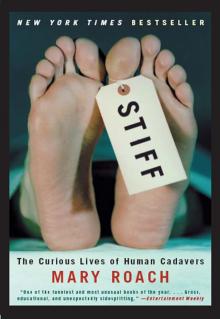 Stiff
Stiff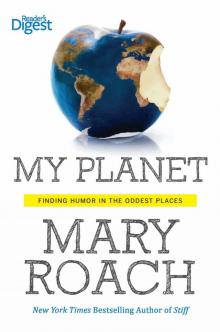 My Planet: Finding Humor in the Oddest Places
My Planet: Finding Humor in the Oddest Places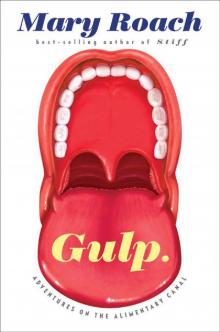 Gulp: Adventures on the Alimentary Canal
Gulp: Adventures on the Alimentary Canal The Best American Science and Nature Writing 2011
The Best American Science and Nature Writing 2011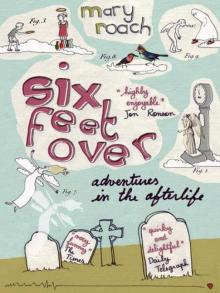 Six Feet Over: Adventures in the Afterlife
Six Feet Over: Adventures in the Afterlife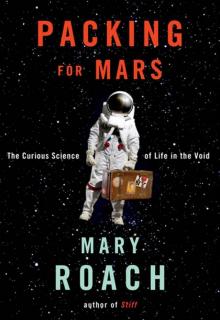 Packing for Mars: The Curious Science of Life in the Void
Packing for Mars: The Curious Science of Life in the Void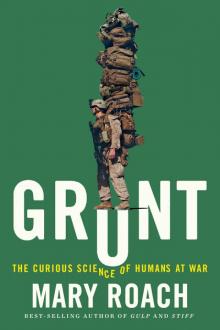 Grunt: The Curious Science of Humans at War
Grunt: The Curious Science of Humans at War